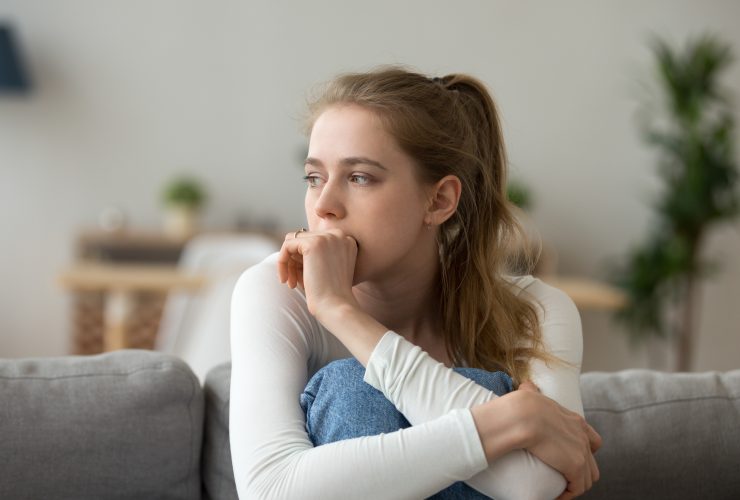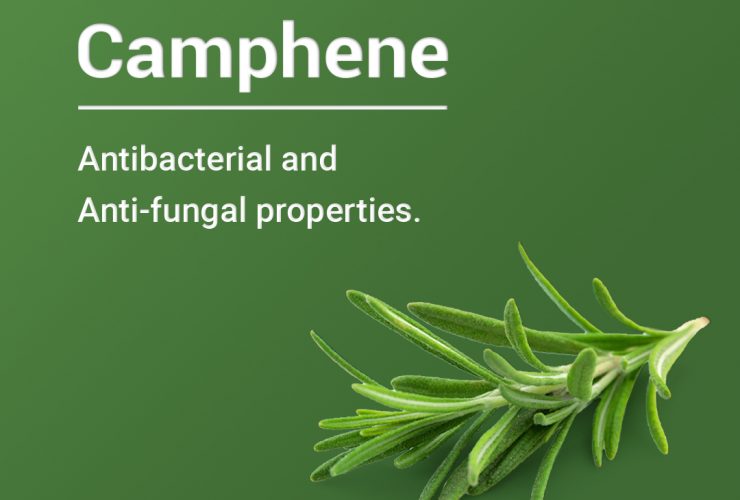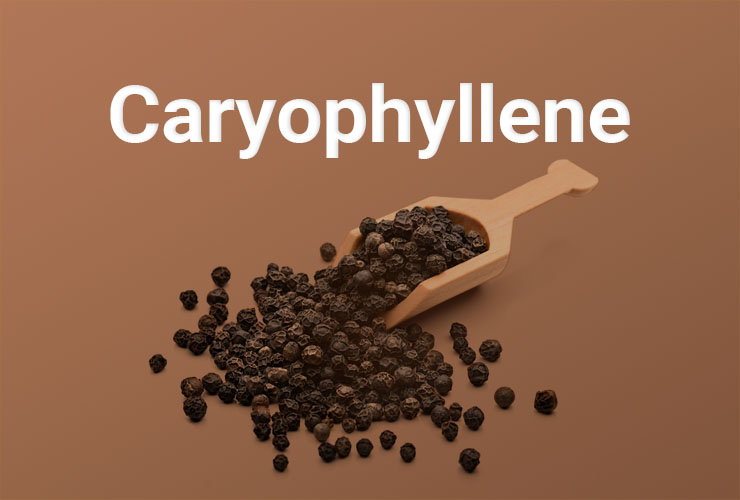Cannabis for Conditions: Social Anxiety

Written by
Cannabis for Conditions: Social Anxiety
Welcome to the Strainprint Cannabis for Conditions Series. This collection of text articles focuses on providing readers and patients with a better understanding of the medical benefits of the constituent wellness molecules—called cannabinoids and terpenes—that can be sourced from the cannabis herb.
Social anxiety, technically called social anxiety disorder and formerly labeled social phobia, is a chronic mental health condition that affects tens of millions of North Americans. According to the Social Anxiety Institute, the condition is “the third largest psychological disorder…after depression and alcoholism,” afflicting an estimated seven percent of the population (about 25 million North Americans).
The National Institute of Mental Health estimates that more than 12 percent of adults in the United States will experience social anxiety disorder at some point in their lives. It is believed that all anxiety disorders affect more than 40 million North Americans.
Understanding Cannabinoids + Terpenes
To truly understand how the cannabis herb can be leveraged by patients to improve their health—and by anyone to proactively and preventively increase wellness—readers need not earn a graduate degree in biochemistry. However, a basic understanding of the dynamics of how the constituent elements of the cannabis plant interact with the human body is necessary to fully appreciate the efficacy provided by the herb and allow patients (and their medical caretakers) to intelligently employ cannabis as an effective treatment therapy.
More than 400 types of chemicals produced by the cannabis plant have been identified, many of which have been studied in clinical research environments. Categorically, these special molecules include cannabinoids, flavonoids, and terpenes. This article series will examine the efficacy of cannabinoids and terpenes for a variety of diseases.
Cannabinoids Defined
Cannabinoids constitute a family of medicinal molecules produced by both the human body and the naturally occurring cannabis herb. To date, 113 cannabinoids have been identified and isolated within the cannabis genome via a variety of research studies and the collection of large volumes of empirical evidence from users.
This basic dynamic—involving supplementation of deficient or damaged human bodies with plant-based medicines, similar to how one consumes a vitamin—illustrates the core benefit of plants like cannabis to humans. Research since the 1960s has revealed the medical benefits of these chemicals for both children and adults suffering myriad diseases and ailments.
The most widely cited and common cannabinoids in cannabis are tetrahydrocannabinol (THC) and cannabidiol (CBD). THC is the fabled psychoactive component of the herb that has become controversial due to the euphoria and shifts in mental alertness and mood that it can deliver. CBD is currently the hottest herbal supplement in the world, providing users with a healthy molecule that, unlike THC, lacks a pronounced euphoric effect and, therefore, is of considerable value to patients who cannot tolerate psychoactivity (such as those engaged in child care and transportation).
Terpenes Defined
Terpenes, sometimes called terpenoids or monoterpenes, represent a group of 200 molecules produced by the cannabis herb that has been shown to provide a wide range of efficacies, including analgesic (pain killing) and anti-inflammatory properties of value in the treatment of literally hundreds of diseases and conditions.
Cannabis is not the only plant that produces medicinal terpenes. In fact, more than 20,000 varieties of terpenes exist throughout nature. The interesting part of the evolution of these odiferous chemicals is that they are shared among different plant species. For example, the terpene linalool—which conveys an aroma of lavender and is present in hundreds of strains of cannabis—also is produced by more than 200 other plants, including lilacs and a variety of herbs and mints.
Terpenes were once thought to deliver nothing more than an enticing aroma to thousands of plants, from cannabis to conifers and lavender to lilacs. From an evolutionary perspective, terpenes help to protect plants from pests and predators with their intense fragrance, acting as a reverse siren song. Within the past couple of decades, however, researchers have learned that terpenes offer medical benefits to all mammals that rival those of their chemical cousins the cannabinoids.
Terpenes constitute approximately 10-20 percent of the total pre-smoked resin produced by the nearly microscopic trichome glands of mature female flowers. It is estimated that 10-30 percent of the smoke resulting from the combustion of cannabis flowers results from terpenes.
Loosely speaking, the three primary efficacy benefits of terpenes are their ability to fight pain, how they reduce systemic inflammation, and their seemingly magical capability to reduce anxiety in some patients, including canines. Depending on the specific terpene cited, a plethora of other primary and secondary benefits exist, including anti-fungal and anti-bacterial properties.
According to Leafly, “Terpenes play a key role in differentiating the effects of various cannabis strains. Some terpenes promote relaxation and stress-relief, while others promote focus and acuity.”
Entourage Effect + Dr. Ethan Russo
It must be stressed that the theoretical efficacy of an individual cannabinoid or terpene is confounded by the fact that it is typically consumed in tandem with other cannabinoids and terpenes (including flavonoids, which will be covered in a future Strainprint Community article).
This is especially true for patients who gravitate toward “full spectrum” and “whole plant” products. This issue is addressed by a prominent theory called the entourage effect, a term coined by Dr. Ethan Russo, M.D., a California-based neurologist and one of the pioneers in the field of cannabinoid and terpene research for serious medical applications.
In 2011, Russo published a research study entitled “Taming THC: Potential Cannabis Synergy and Phytocannabinoid-terpenoid Entourage Effects” in the British Journal of Pharmacology. He and his team studied how cannabinoids and terpenes interact with both one another and the body’s endocannabinoid system (ECS).
In his pinnacle study, Russo explained how cannabinoids and terpenes intermingle in the human body to modify the effects of one another and, in essence, create an overall different, or “greater,” efficacy based on the exact molecular mix present and, of equal importance, the ratios in which these special chemicals appear.
Examples of this nuanced mechanism revealed by the study include the terpene myrcene’s ability to reduce the selectivity of the blood-brain barrier, allowing molecules like THC and CBD to pass this extremely finicky biological filter more easily and in greater volumes. While myrcene illustrates how a terpene can amplify the efficacy and potency of individual cannabinoids, the terpene pinene has been shown to buffer THC by reducing the cognition and memory impairment that sometimes accompanies the infamous psychoactive molecule.
The study revealed that a combination of the terpenes limonene and linalool and the cannabinoid cannabigerol (CBG) is helpful in treating methicillin-resistant staphylococcus aureus (MRSA), the most treatment-resistant form of staph infection. CBD, limonene, and linalool have been investigated for their ability to fight acne and treat other skin conditions, including eczema and psoriasis. When combined with THC, the cannabinoid cannabinol (CBN) produces an enhanced sedative effect.
The pioneering Russo study concluded multiple beneficial interactions between the terpene myrcene and several major cannabinoids, including THC and CBD.
-
CBD + myrcene: Decreases inflammation, fights cancer, reduces pain.
-
CBG + myrcene: Fights cancer.
-
THC + myrcene: Reduces pain and relaxes muscles; delivers sedative and tranquilizing benefits.
Understanding the Endocannabinoid System
The ECS is a complex network of microscopic pairing locations (called binding sites) located throughout the body that manifests in the form of different types of cellular receptors. This network has domain over a multitude of critical bodily functions, including appetite, energy level, mood, slumber, and resiliency to infection and disease, among others.
These cellular receptors are called CB1 (found mostly in the brain and central nervous system) and CB2 (located primarily in the organs and tissues of the immune system found throughout the body) and are the “docking stations” into which cannabinoids fit almost perfectly (something called a strong binding affinity).
Humans produce their own cannabinoids, chemicals labeled endocannabinoid (which are, in medical parlance, neuromodulatory lipids), while the cannabis herb manufactures nearly identical cannabinoids called phytocannabinoids. The major endocannabinoid are anandamide and 2-arachidonoylglycerol (2-AG).
Why is THC so special and noted in the available research documentation? Because it is the plant-based version of 2-AG and what medical researchers label its mimetic phytocannabinoid. In other words, THC is simply the plant-based version of 2-AG (an insight that is often lost on patients and that evades even many medical professionals).
Many top researchers believe, after nearly a century of cannabis prohibition in North America, that medical science has barely scratched the surface of this topic. Several additional ECS receptor types and dynamics are theorized (topics that will be explored in future Strainprint Community articles and series).
The surprise in this dynamic is the fact that all mammals feature an ECS, not just humans. While specific animals, such as dogs and cats, sometimes metabolize the various terpenes and cannabinoids in cannabis slightly differently, all mammals can gain relief from conditions like pain and inflammation to deal with common core diseases such as anxiety, arthritis, cancer, and depression.
Endocannabinoid Deficiency
The theory of endocannabinoid deficiency was first proposed by Russo in his pioneering 2004 research paper entitled “Clinical Endocannabinoid Deficiency (CECD): Can this Concept Explain Therapeutic Benefits of Cannabis in Migraine, Fibromyalgia, Irritable Bowel Syndrome, and Other Treatment-resistant Conditions?” that was published in Neuroendocrinology Letters, an international peer-reviewed medical journal.
The theory of CECD suggests that the ECS of some humans does not produce enough endocannabinoids for the mechanism to function properly and do its job of maintaining overall health and wellness. The theory assumes that this deficiency, in turn, leads to devastating diseases and conditions such as Alzheimers, arthritis, cancer, fibromyalgia, multiple sclerosis, and Parkinson’s Disease that are merely manifestations of this systemic weakness. Why would humans suffer CECD? Contributing factors include poor diet and processed food, lack of exercise and sedentary lifestyle, environmental toxins and pollution, and various forms of stress.
In the development of his theory, Russo examined a large volume of research literature and discovered a peculiar correlation: Many patients suffering debilitating diseases also featured an ECS that produced lower volumes of the endocannabinoids anandamide and 2-AG, something he dubbed endocannabinoid deficiency. In the modern literature, CECD is defined as a lack of homeostasis, or balance, within the ECS, negatively affecting the overall function of several critical bodily systems.
“Due to the entourage effect, whole-plant cannabis seems to adapt to the particular needs of an individual’s endocannabinoid system, sometimes performing the simple miracle not of directly fighting a disease, but instead allowing the body’s natural immune system to better do so itself.” — Gooey Rabinski, cannabis author, 2015.
Concluded Russo and his team of researchers, “Migraine, fibromyalgia, IBS, and related conditions display common clinical, biochemical, and pathophysiological patterns that suggest an underlying clinical endocannabinoid deficiency that may be suitably treated with cannabinoid medicines.”
Understanding Social Anxiety
Like conditions such as arthritis and cancer, social anxiety is a common illnesses in modern society. Also similar to these conditions, patients who suffer all forms of anxiety often find relief in cannabis medicine. The most challenging element of treating social anxiety with cannabis is finding the right strain and avoiding varieties that, ironically, cause additional stress or panic attacks.
According to Rochester, Minnesota-based Mayo Clinic, social anxiety disorder features the following “persistent” symptoms:
-
Fear of situations in which you may be judged.
-
Worrying about embarrassing or humiliating yourself.
-
Intense fear of interacting or talking with strangers.
-
Fear that others will notice that you look anxious.
-
Fear of physical symptoms that may cause you embarrassment, such as blushing, sweating, trembling or having a shaky voice.
-
Avoiding doing things or speaking to people out of fear of embarrassment.
-
Avoiding situations where you might be the center of attention.
-
Having anxiety in anticipation of a feared activity or event.
-
Enduring a social situation with intense fear or anxiety.
-
Spending time after a social situation analyzing your performance and identifying flaws in your interactions.
-
Expecting the worst possible consequences from a negative experience during a social situation.
Long History of Use
To the surprise of many modern-day patients, cannabis has been employed to treat psychological conditions such as social anxiety for centuries. In fact, it’s documented use specifically for anxiety extends back nearly half a millennium to 1563 when the herb was recommended by Garcia de Orta, a Portuguese physician and herbalist, in his book Colóquios Dos Simples e Drogas da India. The pioneering herbalist claimed that cannabis allowed anxiety sufferers to be “delivered from all worries and care.”
In 1621, English clergyman Robert Burton in his book The Anatomy of Melancholy suggested cannabis for the treatment of depression (something he dubbed a “chaos of melancholy”), a common symptom of anxiety disorders. Burton began preaching the efficacy of cannabis for depression after observing his Indian contemporaries doing the same. Interestingly, Burton also recommended satisfying socialization and exercise in the battle against depression.
In 1860, the Ohio State Medical Committee on Cannabis reported (while somewhat hauntingly also predicting the modern opioid epidemic): “As a calmative and hypnotic, in all forms of nervous inquietude and cerebral excitement, [cannabis] will be found an invaluable agent, as it produces none of those functional derangements that render many of the more customary remedies objectionable.”
Related anxiety disorders include Generalized Anxiety Disorder (GAD), panic disorder, and specific phobias (like agoraphobia and arachnophobia). While there is no single cure for social anxiety disorder, a variety of approaches have proven successful for a significant percentage of the patient population, including psychotherapy, medications, and techniques intended to reduce stress and increase relaxation (such as exercise, meditation, and yoga).
A Better Solution?
The appeal of cannabis for anxiety is amplified by the fact that commonly prescribed traditional pharmaceutical drugs often carry a risk of addiction and a slew of negative side effects. To assist patients with their own research, such drugs include Ativan (lorazepam), Prozac (fluoxetine), Valium (diazepam), Wellbutrin (bupropion), Xanax (alprazolam), and Zoloft (sertraline).
Despite the commonality of these drugs, many provide negative side effects that exceed the conditions they are prescribed to treat. These negative side effects include depression, hallucinations, insomnia, and even suicidal thoughts (especially in teen patients). Because cannabis typically delivers none of these unintended side effects and offers no opportunity for overdose, medical professionals and the patient community are seriously considering the natural herb and its constituent molecules in the treatment of all forms of anxiety.
Finding the Right Strain
While some social anxiety sufferers find great efficacy with cannabis, its use is complicated by the polarized and subjective responses of different patients. For example, a single sample of cannabis can relax and soothe one person while eliciting in another a full-blown panic attack.
(According to the Anxiety and Depression Association of America, a panic attack is defined as “the abrupt onset of intense fear or discomfort that reaches a peak within minutes” and includes a minimum of four of the following symptoms: Accelerated heart rate, heart palpitations, shaking, shortness of breath, sweating, and trembling.”)
Patients suffering any type of anxiety and their caretakers are strongly advised to carefully investigate and experiment with different varieties of cannabis. Many strains, such as those listed below, have been shown to provide relief for at least a portion of the patient community suffering from anxiety:
- Blue Dream: A hybrid that offers the energizing efficacy of a sativa with extreme body relaxation and anxiety relief.
- Cannatonic: This CBD-rich strain often features a CBD-to-THC ratio of 1:1, providing benefits beyond those of only THC and a good example of the entourage effect’s role in helping prevent panic attacks and other negative responses. Canna Farms and Tantalus Labs both offer this chemovar.
- Granddaddy Purple: A standard indica and often cited for the management of anxiety, this strain provides body relaxation and a “peaceful mindset.”
- Harlequin: Tantalus Labs stocks this sativa-dom hybrid that provides a large amount of CBD. It may be a good candidate for many patients to combat stress and anxiety while remaining active and productive.
- Jack Herer: THC-rich strains should often be avoided by anxiety patients, but this potent sativa variety is known for its uplifting effect and how it makes users happy.
- Strawberry Cough: Another example of a sativa that has been shown to provide sufferers of social anxiety with relief because, according to Leafly, it “manages to walk the fine line between energizing and calming, making it easy to converse without feeling overly paranoid.”
- Argyle (Nordle) from Tweed-Rich in myrcene with liberal levels of caryophyllene, users say that this strain offers a flood of creativity and calm.
- Snow Dome (LA Confidential) from Aurora: Pinene and myrcene act in synergy in this mellow, relaxing strain.
- Zen’s Garden from Emblem: This balanced THC and CBD strain is praised by patients for helping ease stress.
Patient Testimonials
David Dean is a New Yorker who began suffering debilitating anxiety in his early 30s, shortly after moving to the congested city from smaller, less hectic areas of Colorado and Texas. In a 2017 article, Dean stressed the risks of using cannabis to treat extreme anxiety and provided direction for those considering the herb for their own relief.
“The key thing is to not dive in, but just dip a toe and see how the water feels. I would take one puff, then relax,” he wrote, adding, “The next night, maybe two puffs. I did it very gradually; as with starting any medication, I wanted to find the right amount that worked for me.” Dean stressed that his goal wasn’t to simply “get high.” “This wasn’t about getting stoned. It was about relaxing my mind and nerves,” he wrote.
“If you’ve never smoked [cannabis] before and are attempting to research how you’ll be affected once high, you are going to find no answers,” wrote anxiety patient Paul James for High Times in a 2017 article. “The only way to know is by inhaling the substance yourself and experiencing it first hand. However, with the knowledge that your biology and environment will determine [your specific] experience, you can set yourself up for a more relaxed attempt,” he wrote.
Like Dean, James recommends caution and careful experimentation on the part of anxiety patients seeking to use cannabis in their treatment regimen. “The best way to discover which strain is more likely to subside your anxiety is by doing your own research. Everyone reacts to marijuana differently,” he wrote. James recommended strains such as Granddaddy Purple, Jack Herer, and Strawberry Cough for fellow anxiety sufferers.
Doctor Testimonial
In his 2013 article for Psychology Today entitled “Medical Marijuana for Psychiatric Disorders,” Jeremy Spiegel, M.D., a psychiatry specialist with nearly a quarter century of experience, explained how he has seen the careful medical application of cannabis result in the successful treatment of conditions such as acute anxiety and depression within his own New York-based practice.
“Marijuana as a treatment has not been [widely] studied…due to political factors. Which, ridiculous as it sounds, is like a scientist shunning a particular chemical system in the body for reasons that have nothing to do with science,” wrote Spiegel in his groundbreaking article.
Spiegel stresses to his patients and colleagues the hit-or-miss nature of applying cannabis medicine in the treatment of difficult and extremely subjective conditions like anxiety and depression. “For some, medical marijuana is helpful, not curative,” he said, adding, “But others have been able to eliminate their dependence on other medications altogether.”
The Studies
A 2015 study entitled “Cannabidiol as a Potential Treatment for Anxiety Disorders” that was published in the journal Neurotherapeutics reported that “preclinical evidence strongly supports CBD as a treatment for generalized anxiety disorder, panic disorder, social anxiety disorder, obsessive–compulsive disorder, and post-traumatic stress disorder when administered acutely.”
The study concluded that there is significant potential for the application of cannabis-derived molecules such as CBD for conditions like anxiety and depression. “Overall, current evidence indicates CBD has considerable potential as a treatment for multiple anxiety disorders, with need for further study of chronic and therapeutic effects in relevant clinical populations,” reported the researchers.
A 2012 study entitled “Cannabinoid-related Agents in the Treatment of Anxiety Disorders” and published in the journal Recent Patents on CNS Drug Discovery detailed many of the effects of a variety of cannabis-derived cannabinoids, including CBD and THC, in the modulation and treatment of emotions such as anxiety and fear.
“CBD is not psychotropic, but has nevertheless been shown to play a role in the modulation of behavioral effects of cannabis. In fact, the THC:CBD ratio is the main criterion to define different cannabis chemotypes,” reported the study’s researchers.
This research emphasized the subjectivity of patient responses to different strains and samples of cannabis medicine, providing guidance for both sufferers and their caretakers regarding the conditions leading to this extreme variance in an effort to improve treatment and titration (dosing) protocols.
“The high degree of inter-individual variability in the responses to cannabis is contributed by a wide spectrum of factors, including genetic and environmental determinants, as well as differences in the relative concentrations of THC and other alkaloids (such as [CBD]) within the plant itself,” concluded the study.
A 2011 study entitled “Neural Basis of Anxiolytic Effects of Cannabidiol (CBD) in Generalized Social Anxiety Disorder” and published in the British Journal of Psychopharmacology found that CBD increased cerebral blood flow in the areas of the brain that control emotion and acts in an anxiolytic (anti-anxiety) manner.
Concluded the study’s researchers, who utilized functional neuroimaging and administered 400 mg doses of CBD to participants of this human trials study, “Relative to placebo, CBD was associated with significantly decreased subjective anxiety. These results suggest that CBD reduces anxiety in SAD [Social Anxiety Disorder].”
A 2009 study entitled “Cannabis and Anxiety: A Critical Review of the Evidence” that was published in the journal Human Psychopharmacology: Clinical & Experimental found a correlation between cannabis use and social anxiety, but could not determine causation.
Reported the study, “Cannabis users consistently have a high prevalence of anxiety disorders and patients with anxiety disorders have relatively high rates of cannabis use. However, it is unclear if cannabis use increases the risk of developing long‐lasting anxiety disorders.” The study’s researchers concluded that “the precise relationship between cannabis use and anxiety has yet to be established.”


